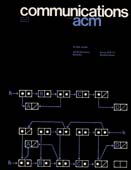June 1976 - Vol. 19 No. 6

Features
A practitioner’s guide to addressing algorithms
This paper consolidates a number of popular rules of thumb which have been suggested for the design of record addressing algorithms, and discusses the applicability of these rules to large commercial databases. Guidelines for selecting identifier transformations, overflow techniques, loading factors, bucket sizes, and loading order are considered. Particular attention is focused on the reasonableness of common heuristics for determining primary or secondary bucket sizes. A mathematical model which explicitly considers storage device characteristics and time/space cost tradeoffs is used to analyze the effect of design parameters on overall system costs. A specific design example is presented and solved.
Interference in multiprocessor computer systems with interleaved memory
This paper analyzes the memory interference caused by several processors simultaneously using several memory modules. Exact results are computed for a simple model of such a system. The limiting value is derived for the relative degree of memory interference as the system size increases. The model of the limiting behavior of the system yields approximate results for the simple model and also suggests that the results are valid for a much larger class of models, including those more nearly like real systems than the simple model. The assumptions and results of the simple model are tested against some measurements of program behavior and simulations of systems using memory references from real programs. The model results provide a good indication of the performance that should be expected from real systems of this type.
A process for the determination of addresses in variable length addressing
An algorithm is presented for the assignment of instruction addresses and formats under the following conditions: (1) the length of the instruction varies as a function of the distance of the instruction from its target; (2) there exists an optimality criterion which implies some preferential choices subject to the addressing constraints. This may be, for example, achieving the smallest number of long instructions, in which case the total code length is minimized, or minimizing the assigned address of a specified point in the program. The algorithm is suitable for arbitrary program structure and a choice of optimization criteria.
An edge reference into a list structure is a pair of pointers to adjacent nodes. Such a reference often requires little additional space, but its use can yield efficient algorithms. For instance, a circular link between the ends of a list is redundant if the list is always referenced by that edge, and list traversal is easier when that link is null. Edge references also allow threading of nonrecursive lists, can replace some header, cells, and enhance the famous exclusive-or trick to double-link lists.
The synthetic approach to decision table conversion
Previous approaches to the problem of automatically converting decision tables to computer programs have been based on decomposition. At any stage, one condition is selected for testing, and two smaller problems (decision tables with one less condition) are created. An optimal program (with respect to average execution time or storage space, for example) is located only through implicit enumeration of all possible decision trees using a technique such as branch-and-bound. The new approach described in this paper uses dynamic programming to synthesize an optimal decision tree from which a program can be created. Using this approach, the efficiency of creating an optimal program is increased substantially, permitting generation of optimal programs for decision tables with as many as ten to twelve conditions.



